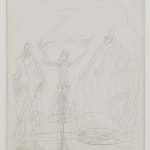Alberto Giacometti Swiss, 1901-1966
Front: « Personages », circa 1951
Back: « Portrait of a man »
Frame: 63 x 56 cm (24 ¾ x 22 in.)
With stand: H 74.5 cm (29 3/8 in.)
Further images
Provenance
Diego Giacometti Collection
Private Collection, given to John Constantin (Diego's step-son) by Diego Giacometti
Francis Briest Sale Twenty-Seven works by Alberto Giacometti, Jun 20th, 1995; lot n° 26, repr. p. 31
Bought during this sale by the current owner
Publications
This work was listed in the Alberto and Annette Giacometti Association archives in 1994.
The work was referenced by the Alberto and Annette Giacometti Foundation under the number 2782. A certificate of authenticity was issued by the Giacometti Committee in September 2013.
A statement of provenance, dated 24.6.1994 will come with this work.
Join our mailing list
* denotes required fields
We will process the personal data you have supplied in accordance with our privacy policy (available on request). You can unsubscribe or change your preferences at any time by clicking the link in our emails.







